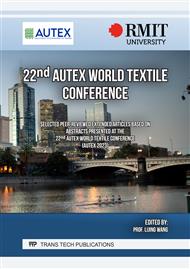[1]
J. Li, K.K. Leonas, Generation Z female consumers' preferences for swimwear products with sustainability-relevant attributes. Journal of Global Fashion Marketing, 13:1 (2022) 44-60
DOI: 10.1080/20932685.2021.1960580
Google Scholar
[2]
T.L.D.L.P. Girão, Sustainable swimwear in Portugal: Perceptions and purchase intentions [Doctoral dissertation, Universidade Católica Portuguesa], 2020. http://hdl.handle.net/10400.14/ 29715
Google Scholar
[3]
J. Wu, 10 - Development and design of performance swimwear, Editor(s): N. Pan, G. Sun, In Woodhead Publishing Series in Textiles, Functional Textiles for Improved Performance, Protection and Health, Woodhead Publishing, pp.226-248, 2011. https://doi.org/10.1533/ 9780857092878.226.
DOI: 10.1016/b978-1-84569-723-5.50025-3
Google Scholar
[4]
J. Li, K.K. Leonas, Trends of Sustainable Development Among Luxury Industry. In: Gardetti, M., Muthu, S. (eds) Sustainable Luxury. Environmental Footprints and Eco-design of Products and Processes. Springer, Singapore, 2019
DOI: 10.1007/978-981-13-0623-5_6
Google Scholar
[5]
M.C. Amaral, W.F. Zonatti, K.L. Silva, D.K. Junior, J.A. Neto, J. Baruque-Ramos, Industrial textile recycling and reuse in Brazil: case study and considerations concerning the circular economy. Gest. Prod., São Carlos, v. 25, n. 3, (2018) 431-443
DOI: 10.1590/0104-530X3305
Google Scholar
[6]
S. Kumartasli, O. Avinc, Important Step in Sustainability: Polyethylene Terephthalate Recycling and the Recent Developments. In: Muthu, S.S., Gardetti, M.A. (eds) Sustainability in the Textile and Apparel Industries. Sustainable Textiles: Production, Processing, Manufacturing & Chemistry. Springer, Cham., 2020
DOI: 10.1007/978-3-030-38013-7_1
Google Scholar
[7]
R. Stefani, Olympic swimming gold: The suit or the swimmer in the suit?' Significance, 9 (2) (2012) 13–17.
DOI: 10.1111/j.1740-9713.2012.00553.x
Google Scholar
[8]
N.-W. Li, C.-P. Ho, K.-L. Yick, J.-Y. Zhou, Influence of inlaid material, yarn and knitted structure on the net buoyant force and mechanical properties of inlaid knitted fabric for buoyant swimwear. Textile Research Journal, 91(13–14) (2021) 1452–1466
DOI: 10.1177/0040517520981742
Google Scholar
[9]
N.-W. Li, C.-P. Ho, K.-L. Yick, J.-Y. Zhou, Development of laid-in knitted fabric for buoyant swimwear. Journal of Industrial Textiles, 51(9) (2022) 1397–1411
DOI: 10.1177/1528083719900932
Google Scholar
[10]
S. Nazemi, R. Khajavi, H.R. Far, M.E. Yazdanshenas, M. Raad, Effect of hydrophobic finishing on drag force of swimwear. International Journal of Clothing Science and Technology, 30 (1), (2018) 2-15
DOI: 10.1108/IJCST-09-2016-0109
Google Scholar
[11]
H. Moria, H. Chowdhury, F. Alam, A. Subic, A.J. Smits, R. Jassim, N.S. Bajaba, Contribution of swimsuits to swimmer's performance. Procedia Engineering, Volume 2, Issue 2, (2010) 2505-2510.
DOI: 10.1016/j.proeng.2010.04.023
Google Scholar
[12]
I. Rogowski, K. Monteil, P. Legreneur, P. Lanteri, Influence of Swimsuit Design and Fabric Surface Properties on the Butterfly Kinematics. Jounral of Appied Biomechanics 22(1) (2006) 61-6
DOI: 10.1123/jab.22.1.61
Google Scholar
[13]
G. Montagna, A. Catarino, H. Carvalho, A.M. Rocha, Study And Optimisation of Swimming Performance In Swimsuits Designed With Seamless Technology, AUTEX 2009 World Textile Conference, 26.28 May, 2009 Izmir, Turkey
Google Scholar
[14]
https://www.batoko.com/ , accessed on April 2023.
Google Scholar
[15]
T. Vadicherla, D. Saravanan, Textiles and Apparel Development Using Recycled and Reclaimed Fibers. In: Muthu, S. (eds) Roadmap to Sustainable Textiles and Clothing. Textile Science and Clothing Technology. Springer, Singapore, 2014
DOI: 10.1007/978-981-287-065-0_5
Google Scholar



